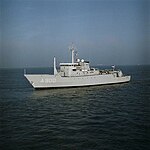Royal Netherlands Navy Submarine Service
| Royal Netherlands Navy Submarine Service | |
|---|---|
| Onderzeedienst | |
 Emblem of the OZD | |
| Founded | 21 December 1906 |
| Country | |
| Branch | Royal Netherlands Navy |
| Part of | Ministry of Defence |
| Engagements | |
The Royal Netherlands Navy Submarine Service (Dutch: Onderzeedienst; OZD) is a department within the Royal Netherlands Navy that is responsible for the deployment of Dutch submarines. It was established out of the Netherlands Torpedo Service on 21 December 1906, and merged with the Netherlands Mine Service on 15 July 2005.
History
Early history
The Royal Netherlands Navy Submarine Service (OZD) was established on 21 December 1906. In this year the Royal Netherlands Navy commissioned its first submarine, HNLMS O 1. The OZD was tasked with taking care of the equipment of the submarines and the training of the crews.
At this time there were still doubts about the usefulness of submarines. Royal Netherlands Navy officers did indeed see an "interesting and ingeniously constructed mechanism in the vessel,"[
World War II
During World War I and the interwar period, the Royal Netherlands Navy ordered and built many submarines. As a result, at the start of World War II, the OZD had more than 20 submarines at its disposal.[1] On 10 May 1940, the Royal Netherlands Navy had three operational submarines in the Netherlands, namely HNLMS O 9, O 10, and O 13.[2] HNLMS O 11 was being repaired, while O 8 and O 12 were undergoing maintenance.
Meanwhile, HNLMS O 14 and O 15 were active at the time in the Caribbean. Furthermore, seven submarines were in various stages of completion at different yards.[2] On the other hand, the Dutch navy had 15 operational submarines in the Dutch East Indies.[3] These submarines played an important role during the war, by confronting and sinking enemy ships. For example, HNLMS O 16 and K XVII sunk several Japanese ships in 1941.[4] However, there were also losses in this theater, both HNLMS O 16 and K XVII were sunk in December 1941.[4]
Expansion

After 1945, the OZD had eight submarines, but due to intensive use in the war these were in a bad condition.[1] Also the fact that the fleet consisted of different classes was a problem. It made maintenance and exercise of crews very pricey. Due to the economic malaise and the high costs caused by operations in the Dutch East Indies, there was no money left for new construction. In the end the navy managed to take four submarines on loan from the British and the Americans. In 1946, the Netherlands still had a total of eight operational submarines in service: HNLMS O 21, O 23, O 24, O 27, Dolfijn, Zwaardvisch, Zeehond, and Tijgerhaai.[5]
Since the home port at Den Helder was in ruins, these submarines were for the time being using the Waalhaven in Rotterdam as their base.[5] For the OZD, this period just after World War II meant depending on Dutch pre-war submarines and second-hand British and American submarines. The commissioning of the Dolfijn-class submarines in the early 1960s was an important milestone. The four boats formed the backbone of the OZD during a large part of the Cold War; they were in service from 1960 to 1992.[6]
Cold War
The Dutch submarine fleet never reached the size it had before the World War II again.
In the period from 1970 to the 1990s, the crew of the six Dutch submarines secretly gathered information about the Soviet Union. Most of the other missions the OZD carried out remain secret to this day.[7]
Vessels
| Class | Photo | Type | Number | Introduced | Notes |
|---|---|---|---|---|---|
| Walrus | 
|
Submarine | 4 | 1994 | Multi-purpose diesel-electric powered hunter-killer submarines for deep ocean, brown water, and special force operations |
| Mercuur | 
|
Submarine tender | 1 | 1987 | Submarine support vessel and MCM command, upgraded in 2017 |
See also
References
Footnotes
- ^ a b c d Peter van der Hoest (20 September 2006). "Een eeuw onderzeeboten". www.maritiemnederland.com. Retrieved 10 May 2018.
- ^ a b De Bles et al. 2006, p. 95.
- ^ De Bles et al. 2006, p. 99.
- ^ a b Van Royen 1997, p. 7.
- ^ a b De Bles et al. 2006, p. 101.
- ^ "Driecilinder onderzeeboten". www.marineschepen.nl. 7 May 2018. Retrieved 10 May 2018.
- ^ Raymond Boere (17 June 2017). "Nederlandse onderzeeërs bespioneerden de Russen". www.ad.nl. Retrieved 10 May 2018.
Bibliography
- Anten, J. (2011). Navalisme nekt onderzeeboot (in Dutch). Amsterdam: Pallas Publications. ISBN 9789048514359.
- Bezemer, K. W. L. (1987). Zij vochten op de zeven zeeën (in Dutch). Houten. ISBN 9789026920455.)
{{cite book}}: CS1 maint: location missing publisher (link - De Bles, H.; Boven, G.; Homburg, L. (2006). Onderzeeboten! (in Dutch). Zaltbommel: Aprilis. ISBN 9059941306.
- Jalhay, P. C.; Wijn, J. J. A. (1997). Ik nader ongezien! De onderzeeboten van de Koninklijke Marine (in Dutch). Amsterdam: De Bataafsche Leeuw. ISBN 9067074624.
- Karreman, J. (2017). Spionage-operaties van Nederlandse onderzeeboten van 1968 tot 1991 (in Dutch). Amsterdam: BWV Media. ISBN 9789082699500.
- Schoonoord, D. C. L. (2012). Pugno Pro Patria: De Koninklijke Marine tijdens de Koude Oorlog (in Dutch). Steenwijk: Van Wijnen–Franeker.
- Van Beers, A. C. (1945). Periscoop op! De oorlogsgeschiedenis van den onderzeedienst der koninklijke marine (in Dutch). Amsterdam: Scheffer en Sikkema.
- Van Royen, P. C. (1997). Hr.Ms. K XVII en Hr.Ms. O 16 (in Dutch). Amsterdam: Van Soeren. ISBN 90-6881-075-8.
External links
- Official website
 (in Dutch)
(in Dutch)
